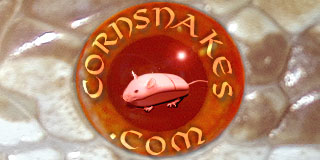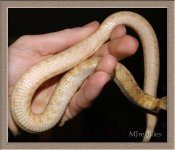I have no recent experience with breeding Diffuses. I bred them many, many years ago, and when I had an entire clutch of Diffuses die from not eating I got out of them. HUGE MISTAKE! Perhaps some of those who are currently breeding Diffuses can answer some of my questions that I have when I read about the Diffuse pattern on the forums.
I am currently caught up in the Diffuse Craze and out crossing many of my corns with Diffuses this year. Lava X Classic Diffuse(Bloodred), Lava X Charcoal Diffuse(Pewter), Amel Diffuse X Very Red Amel Okeetee and a few others. I have a feeling that I will be very confused when I look at the F1’s and even the F2’s. Which are Diffuses or have the Diffuse pattern and which are not. I think it will be a matter of opinion with most of them and very evident on some.
This does not seem to be a simple recessive trait or co-dominant trait in my opinion. In either case, it would be very clear. If you breed a Motley with a normal het for Motley, it is very obvious that the Motley gene is recessive and is more than just a white belly recessive trait. Half of the offspring will be Motleys and the other half will look normal. There are exceptions of course. (White bellies that you can’t tell if they are motley or normal, but rare) A co-dominate or semi-dominate Salmon Hypo Boa gene is an all or nothing gene. Yes, I am into boas too!. The offspring are either Salmon Boas or regular boas. The regular boas do not carry the gene and can never produce a Salmon Boa. This does not seem to be the case with Diffuses. It is not an all or nothing semi-dominant mutant gene, but seems to be more related to the normal partially dominant pattern genes of corn snakes. The Diffuse belly pattern does seem to be recessive, with a normal partially dominant Diffuse pattern that can be present.
So is the Diffuse gene a mutant recessive gene or mutant semi-dominant gene or perhaps a combination of recessive (belly pattern) and normal genes partially dominant for pattern and color genes? Much like an Okeetee crossed with something else will most likely show some Okeetee traits like the black borders, which is a type of a normal partially dominant pattern trait. The same happens with Miami phase corns when crossed with other corns. The normal partially dominant Miami phase color shows up on F1’s and is not of the mutant type recessive or semi-dominant genes.
I am an old timer I guess, but don’t feel like it yet. Classic Diffuse(Bloodred) Corns are ingrained in my vocabulary as a distinctive type of corn. All of the Charcoal Diffuse(Pewters), Anery Diffuses, Amel Diffuses, Butter Diffuses and other Diffuse Crosses are a result of out crossing and are out crossed Diffuses. The original type Classic Diffuse(Bloodred) color and pattern are in the process of being recovered with selective breeding. A very Classic looking Diffuse(Bloodred) which is very dark red with the Diffuse pattern, can be het for Anery A and when bred to another Classic Diffuse(Bloodred) het Anery A, will produce Classic Diffuse(Bloodreds) and Anery A Diffuse. These Anery A Diffuses are genetically Diffuses, but are expressing a recessive mutant gene. When they are bred to a Classic Diffuse(Bloodred), they will produce more Classic Diffuses(Bloodreds). This is why I would have a problem replacing the name of an Anery or Carmel, or Butter Diffuse, with “skizzle” Butter for example. These homo mutant Diffuses are genetically the same, or should be, and can produce Classic Diffuses(Bloodreds) when bred to a Diffuse.
I think the very dark, dried blood color of a Classic Diffuse(Bloodred) can have an effect on a mutant homo Diffuse. A Lavender Diffuse may be a darker shade of purple than a standard Lavender. But when a Lavender Diffuse is bred to a Classic Diffuse(Bloodred), it should still produce a Classic Diffuse (Bloodred). This will be the standard that I will strive for with my Lava X Charcoal Diffuse(Pewter), and Lava X Diffuse Projects. I will also strive for the Classic Diffuse(Bloodred) pattern in all of my mutant creations. The more exaggerated the better! An Amel Diffuse should produce a Classic Diffuse(Bloodred) when bred to a Classic Diffuse(Bloodred). I would expect that a Butter Diffuse would be a different color than a Butter and have a very exaggerated Diffuse pattern or what is the point? But when this Butter Diffuse is bred back to a Classic Diffuse(Bloodred), it should produce a Classic Diffuse(Bloodred). If we only focus on the Diffuse Pattern and call it “skizzle“ Corn, then I think much is lost. You can describe the Diffuse pattern any way that you want to, but it is still a Diffuse pattern.
WOW! I just saw the Lavender Diffuse that Rich Z posted. That is nice! It is what I would expect a Lavender Diffuse to look like. I bet if he bred it to a Classic Diffuse(Bloodred) it would produced Classic Diffuses(Bloodreds) het for Lavender. It is a Lavender Diffuse and could be named something else, but to group all of the different mutant Diffuse morphs into a "skizzle" group seems wrong to me. They are already in a group called Diffuse.











